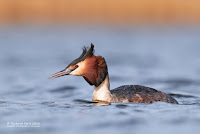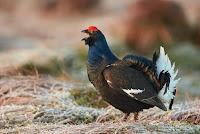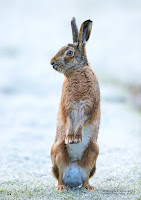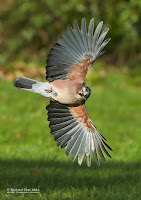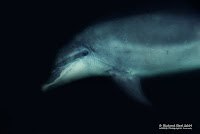So with the grind of snow tires on tarmac once more we drove through the strange scenery of the volcanic landscape.. Over mountains, through valleys with deep snow, past tumbling waterfalls, alongside fast flowing gravel rivers, the landscapes of Iceland passed at a steady 56 km per hour. Somewhere en route, but don't ask me where as I couldn't tell you, we where passing this lake and two large black birds close to the margin just caught the corner of my eye.
It was was freezing with a harsh breeze cutting across the lake.We managed a few photos of the birds as they tracked along the margins. This included a photo I was wanting to get of the lines of water beads which form on the birds heads when they surface.
The birds were steadily moving to the far side of the lake shown in the photograph above, so we followed and figured if they hit the far bank then we could get some more favourable light on them. However, they never made it that far and dived around the couple of small islands before heading off back up the long lake. We obviously did not know it at the time but these would be our last Great Northern Diver photographs of the trip. It has been such a pleasure over the previous few days to occasionally be in the presence of these magnificent birds.
The kilometers passed as did the hours. Periodically we would stop to have a break and stretch the legs and take in a view or two.
We pulled into one lay-by for a break opposite an attractive waterfall tumbling down into a fast flowing river. There was a sign there explaining the view but it was all about the small bridge rather than the cascade, describing it to be the first concrete bridge built in Iceland. I suppose in a country that has so many waterfalls its first concrete bridge is more of a novelty.
As you can see as we were heading south the weather was improving. At least it was until around 70kms north of Borgarnes where there was a tiny roadside lake in the mountains with a Great Northern Diver which we had spotted on our journey north a few days early. This was unusual given the birds preference for large bodies of water and potentially offered a good photo opportunity. The bird was still there and so we stopped. Unfortunately the weather had other plans and dark skies poured in on the strong upland winds accompanied by lashing rain, sleet and hail. In the distance down in the valleys it was clear and sunny, the weather was forming over the mountains. We waited a while to see if it would clear but the nasty weather just kept developing over the summits and in the end we gave up.
We finally arrived in Borgarnes in the late afternoon when we pulled once more into the car park of the Hotel Bru. The birch scrub surrounding the car park alive with the song of Redpoll and Redwing and the calls of Snipe. It would appear that familiarity gives discount as we got the the same sized room for the night for about 25% less than our visit a few days earlier. Having settled in to our room we pulled out the maps to see if there was anywhere to head with the cameras that evening. A short distance to the North-West was the Myrar peninsula which was reportedly a good area for Red-Throated Diver so we thought we would try that, making the circuit around road 533. Well we did see divers, in fact we saw a pair mating, but all rather distant. It was in fact very quiet along the road in terms of birds but the wind was very strong and bitterly cold and I expect a lot were lying low.
It struck me after we had just photographed a Golden Plover to the side of the gravel track that despite being so common I had not really got any really good photos of Golden Plover.
This often happens when you are overseas and with the very common birds that you think you will have plenty of opportunities to photograph them at some point in the trip and then you suddenly realise you are running out of days rapidly and still haven't really photographed them. We came across a Golden Plover and so I asked Steve to stop the 'campervan' and I was going to try and creep up on it on foot. This went well and I got some frame filling images I was happy with in the soft evening sun.
A slight shift in position to change the background.
While I was creeping up on the bird, there was suddenly the alarm call of a Black-tailed Godwit which had become upset by a hunting Arctic Skua. Steve, who had stayed in the van, managed to get some photographs of both of these birds in flight. Mind you I was more than content with the 'GP' photos. My view is the only competition there should be in wildlife photography should be with yourself.
We picked up the Skua again further down the road but it refused to come over to the side where it would be nicely lit and so had to make do with some photos in some tricky back light.
The gravel road seemed to go on for ever and with the lack of birds and the amount of time we had been on the road that day our enthusiasm was waning rapidly, so we decided to pack it in and head for some food in Borgarnes before returning to the hotel.
Checking the weather forecast for the next day, we decided we would stay in the area and head north and west along the Snaefellsnes Peninsula (we called it 'Snaffles' for ease). This was an area neither of us had intended to head to or had really done any background research on, so we would just have to head up there and see what we could find on our travels.









































